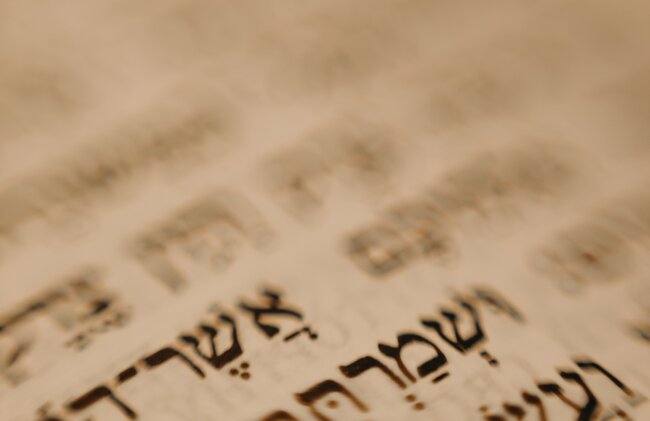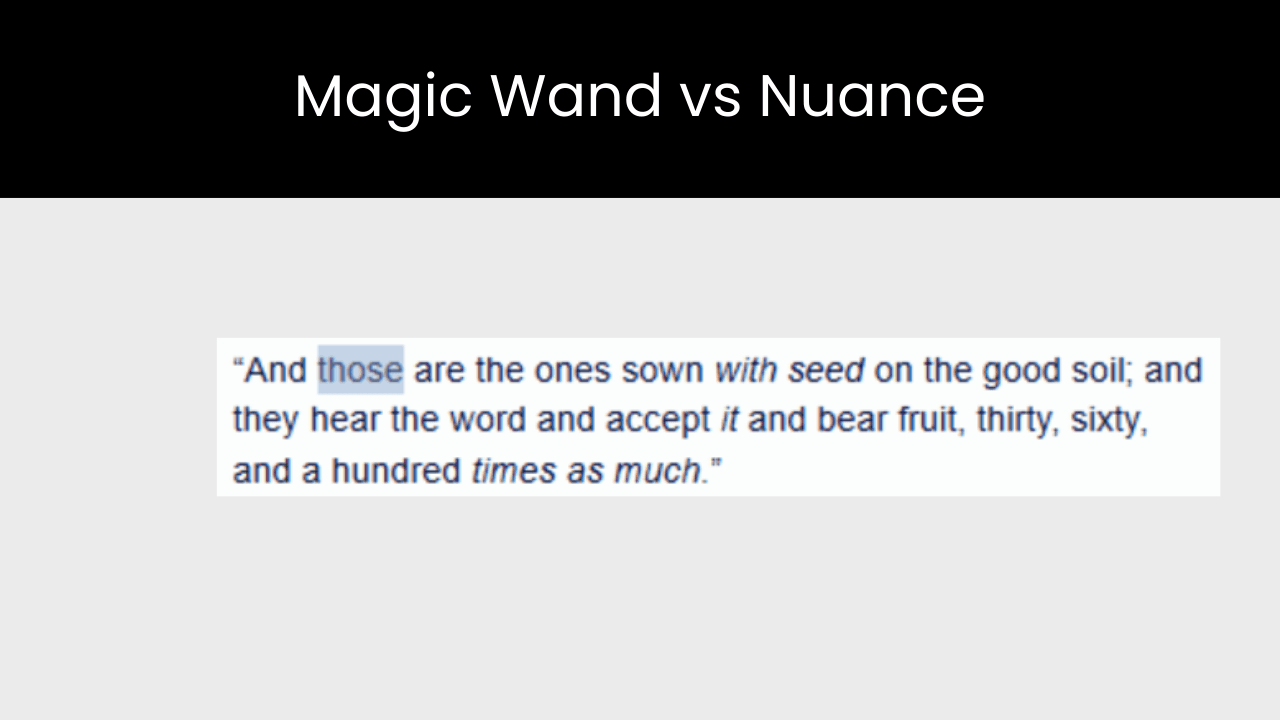Transmitting the Old Testament: Adventures of the Hebrew Text – Part 1
1. Introduction
We are all familiar with family heirlooms. An object, usually of significant sentimental value, is handed down from one generation to the next. The Bible is a little like that heirloom. Successive generations of scribes wrote down the words of the Bible, copying what former scribes had written. We have long since lost those first copies but, thanks to all the intermediate copies, we can have and hold a Bible today.
It is easy to think that transmitting the biblical text is a relatively simple matter. This is probably because (a) we have never tried copying a document long hand and (b) we are accustomed to printed Bible editions with clear, consistent lettering. In truth, copying a Bible is very hard work and it is worth learning something of the transmission process so that we can be grateful to those who have made our (now) easy-to-read editions possible. In what follows I will describe significant parts of the transmission process for the Old Testament—the part of the Bible written in Hebrew and Aramaic. The process for the transmission of the New Testament is somewhat different, and is best treated separately.
2. The Old Testament: Now One, Formerly Many
The Hebrew/Aramaic Old Testament, known to Hebrew speaking people by the acronym Tanak (T=Pentateuch/Torah; n=Prophets/Nevi’im; k=Writings/Ketuvim), was composed over the space of about 1000 years (somewhere after the time of Moses to somewhere after the time of Ezra). This means that what we now refer to as the Old Testament was for many years not a single entity, but a collection of separate works. Later written Bible books were not added immediately to the previously written books into some sort of giant ring binder, but were kept separate.
There are at least two reasons why Bible books were kept separate rather than being bound together. One is practical: all Bible ‘books’ began their physical existence as scrolls—rolls of parchment (i.e., leather prepared for writing purposes) with writing on only one side. It would not have been practical or possible to include all books in one massive scroll. As a point of comparison, imagine how much thicker all of our Bibles would be if they have been printed on only one side of the page. Considering that parchment is many times thicker than the thin Bible paper of today, and that printing presses can maintain legibility while using a much smaller font size than a handwritten text, you then begin to see why the Bible could not have been a book but a collection of holy writings for at least half of its 3,000 year plus history. (At some point, Jews started putting the entire Pentateuch into a giant scroll which was used for synagogue reading, but this is not a practical solution for most situations—and anyway, this large scroll still contained only five books, not 39.) It was not until the age of printing in the early 16th century that Bibles containing all the 39 books1 were regularly included between two covers. In other words, the current presentation of the Bible, whose form we unthinkingly accept, is a phenomenon that is barely 500 years old, a mere one-sixth of the life span of its oldest parts.
The second reason that later-written Bible books were kept separate from earlier-written Bible books was because later works were deemed to have a slightly lower stature than previous books. A sort of tripartite separation is still maintained by Jews with the Torah (Gen-Deut) outranking the ‘Prophets’ (Josh, Judg, Sam, Kings, Isa, Jer, Ezek, plus the Minor Prophets), which in turn outrank the ‘Writings’ (the remainder of the biblical books).
Jesus, it is to be remembered, generally referred to the first two sections only, i.e., the “the Law and the Prophets” (see Matt 7:12; 22:40). Among Christians today an explicit hierarchy no longer exists among the books just mentioned, although Christians who also accept the deuterocanonical books, (the Apocrypha), generally assign these books to a lower tier than the rest of the Old Testament. In place of a hierarchy of importance among the Old Testament books, Christians see the important division as coming between the Old Testament and the New Testament.
Practically speaking however, Christians today implicitly view some Old Testament books as being more important than others, even if those views are never officially acknowledged. Witness the fact that for every sermon drawn from Leviticus (27 chapters long), there will probably be several dozen sermons preached from Ruth (4 chapters long). Likewise, the message of the Minor Prophet Jonah is well known while most of us would struggle to match the message with the book name for the remaining 11 Minor Prophets (just try it and see how far you get).
3. Why Trying to Fix a Date for the Writing of Biblical Books is Mostly Unhelpful
Christians often find themselves in disagreement with those who study the Bible academically, in part because Christians tend to believe that Moses wrote the Pentateuch while academics overwhelmingly claim that it was written much later (sometime after David became king in Jerusalem). While I do not wish to minimize the ideological differences from whence these two viewpoints arise, it is worth pointing out one little discussed feature. Namely, the majority of the Pentateuch, in the form of Hebrew that has been passed down to us, likely does not date prior to the time of David (c. 1000 BCE). This claim can be made because Hebrew, like all languages, underwent gradual changes during its history.2
An example may be helpful. If we found the English sentences “What’s up?” and “How dost thou fare?” written side by side, we could (rightly) infer that the former sentence is modern spoken English, while the latter is Elizabethan (found in Shakespeare, Henry VI). This example demonstrates a bit of the difficulty that one faces when trying to make sense of language change in Hebrew: namely, the Hebrew of a book like Genesis appears to be that of the Kings of Judah, and not from a previous period. This does not mean, of course, that the Pentateuch is only as old as David. It merely means that the form of the text, as it currently stands, shows a language form that fits better with David than with prior periods.
Rather than supposing such a conclusion to be hostile to faith, however, one could conclude the opposite. Specifically, the only way a biblical text can be dated to a certain period is if the text has remained relatively unchanged throughout the subsequent centuries and millennia. The fact that the Bible does show an astonishing amount of difference in the form of the Hebrew used throughout its books demonstrates not that biblical writers and transmitters were unconcerned with correct copying but actually tried very hard to record precisely what was before them (more of this below).
One could still object, claiming that a language update of the Pentateuch from the time of David shows a potential disregard of that scribe(s) for previous writers. While this is a valid point, it should scarcely come as a surprise that books such as Genesis had a long oral tradition before being committed to writing.3 In point of fact, the parts of the Pentateuch where the ‘oldest’ features occur (Ex 15, for instance) are generally in the form of poetry rather than prose—perhaps indicating that songs-poems were passed down through near word for word memorization while the narrative portions were transmitted more nearly as thought for thought.4
4. The ‘Hebrew’ Bible of the Early Church: The Septuagint
Around 250 BCE, the Greek ruler of Egypt, Ptolemy II, commissioned a translation of the Pentateuch into Greek. This event marked the first known translation of the Old Testament, an example which has been repeated some 2,000 times since for other languages. Ptolemy’s motive for requesting a translation is not entirely clear, although we do know that many Jews had begun speaking Greek prior to that point, and thus would have benefitted from a Greek translation.5 This translation, of which no original copies survive, became known as the Septuagint (Septuagint being the Latin word for 70—the supposed number of translators that had worked on that first translation of the Pentateuch). Over the next several centuries, the remaining books of the Old Testament were also translated and circulated widely.
The Septuagint was highly regarded, and in some circles was considered to be of equal or greater significance than the original Hebrew text. For example, Philo of Alexandria, a Jewish philosopher from Egypt who was roughly contemporary with Jesus, believed the translation to have been guided by God (inspiration in the translation process, if you will). In Philo’s telling of the translation process, each translator, working individually, selected identical Greek words when attempting to express a recurrent Hebrew phrase or idea. When everyone’s work was assembled, voilà!, there lay a perfect translation with consistent and precise renderings of every word and concept. Philo’s claim regarding the exact correspondence of all Greek renderings to the Hebrew base text is factually untrue, although Philo can perhaps be forgiven as his knowledge of Hebrew—if he knew much at all—was significantly overshadowed by his knowledge and love of Greek.
But it was not only the Hellenized Philo who regarded the Septuagint as authoritative. For example, in the Apostle Paul’s many references to the Old Testament, he, more often than not, quotes from the Septuagint. Some of these instances can perhaps be attributed to a reformulation of the basic idea found in the Hebrew text, but there are clear instances where Paul’s use of the Septuagint is uncontested. We know this because it happens that the wording of the Hebrew and Greek texts sufficiently differ to make such an observation possible. Paul’s choice to quote from the Septuagint is particularly arresting as Paul, unlike Philo, seems to have known Hebrew quite well and yet still decided to draw from the Septuagint.
Although most Christians today hold the Septuagint in somewhat lower esteem than they once did, the Septuagint’s influence continues to the present, sometimes in surprising ways. For example, the small whitish substance mentioned in Exodus 16 and Numbers 11 that we know as manna, is pronounced man and not man-uh. Where did that final -uh come from? The Septuagint.
In some cases, the Septuagint’s translation choices still influence our understanding of the meaning of a Hebrew word. For example, the word torah (תּוֹרָה) was translated into Greek as nomos (which has subsequently come down to us English speakers as ‘law’). While ‘law’ is not an entirely incorrect substitution for torah, a better translation is ‘teaching,’ as can be demonstrated from Prov 1:8. In two parallel lines the proverb runs as follows:
My son, hear the instruction of thy father,
and forsake not the law (literally, torah) of thy mother.
In this proverb, the instruction of the father and the law of the mother are not to be understood in a judicial sense as the word ‘law’ could seem to indicate. Instead, ‘law’ probably refers to practical advice that the father and mother have attempted to pass down to their son. For example, the parents are telling their son not to drink too much, to keep the right friends, and to avoid being misled by immediate gratification. Why? Because the parents know that doing these things will help their son to lead a life of success. They are not concerned that their son stay out of jail (judicial law); they want him to lead a fulfilling life (practical advice). Due to the prestige and lasting influence of the Septuagint, however, the word torah is often viewed in a rather more narrowly legalistic light.6
For reasons such as these, the Septuagint, although ostensibly only a translation, is not a translation to be disregarded. Christians today do not agree on its level of importance, but all have been impacted by it.
To be continued…
ENDNOTES
1 According to the Christian count, there are 39 books of the Old Testament. Although Jews include exactly the same books, the ordering and the counting of the books is different, making 24 books instead of 39 (books with two parts are counted as one, Ezra/Nehemiah is one book, and the 12 Minor Prophets are counted as one book). Return to context⬏
2 Should one wish to learn more regarding language change in Biblical Hebrew, a good starting point is How Old Is the Hebrew Bible? written by Jan Joosten and Ronald Hendel (Yale University Press: 2018). The book is clearly written and can be read without any knowledge of Hebrew. Of course, if someone wants to understand the why behind the what, knowledge of Hebrew will be essential. Return to context⬏
3 Alphabetic writing probably originated with the Phoenicians sometime during the second millennium BCE, from where it spread eastward towards Semitic speaking people and westward towards Greece. The advantage of alphabetic writing (as opposed to Egyptian hieroglyphs) was in its brevity. Writing the Torah in hieroglyphics would have been very difficult logistically, not to mention the fact that such writing was Egyptian—and thus unsuitable for writing in Hebrew. Return to context⬏
4 Although the foregoing does represent my views regarding the Hebrew of the Old Testament, it should be noted that Christian scholars are by no means unanimous in their views regarding the dates when the various books were written. Thus, I may be incorrect in my claims. Before someone takes issue with what I have described, however, I would encourage them to first learn enough Hebrew to make sense of the various points of view regarding the proposed dates of the biblical texts. When we understand the arguments, we are in a better place to productively engage with them. Return to context⬏
5 It is by no means certain that the idea to translate the Hebrew Bible originated with Ptolemy, particularly as the Letter of Aristeas, from which this claim derives, appears to be partially intended as a glorification of the translation and is therefore to be read with all due caution. Return to context⬏
6 Is it possible that a harsher understanding of torah has made Christians, even unconsciously, less warm and more retributive than they would otherwise be? I do not have an answer, but I think the question is worth considering. Return to context⬏










Leave a Reply